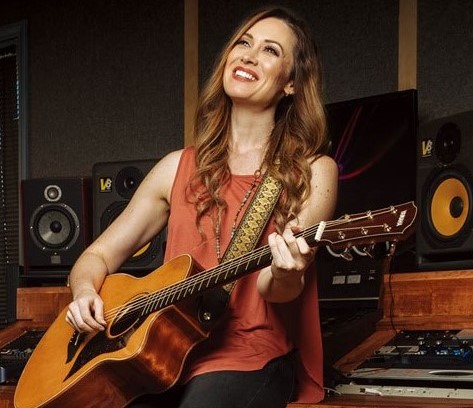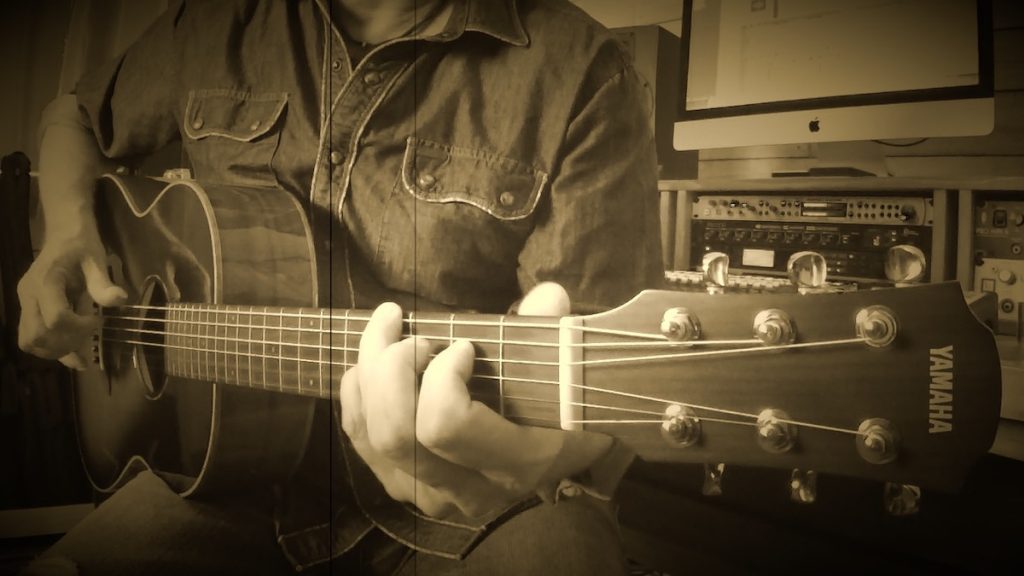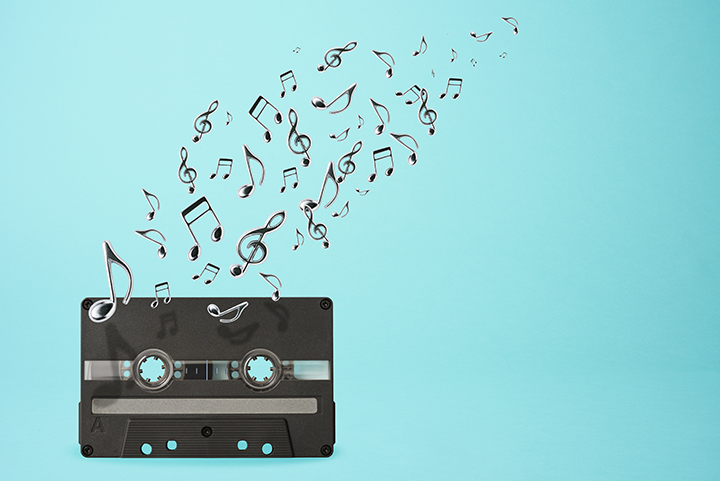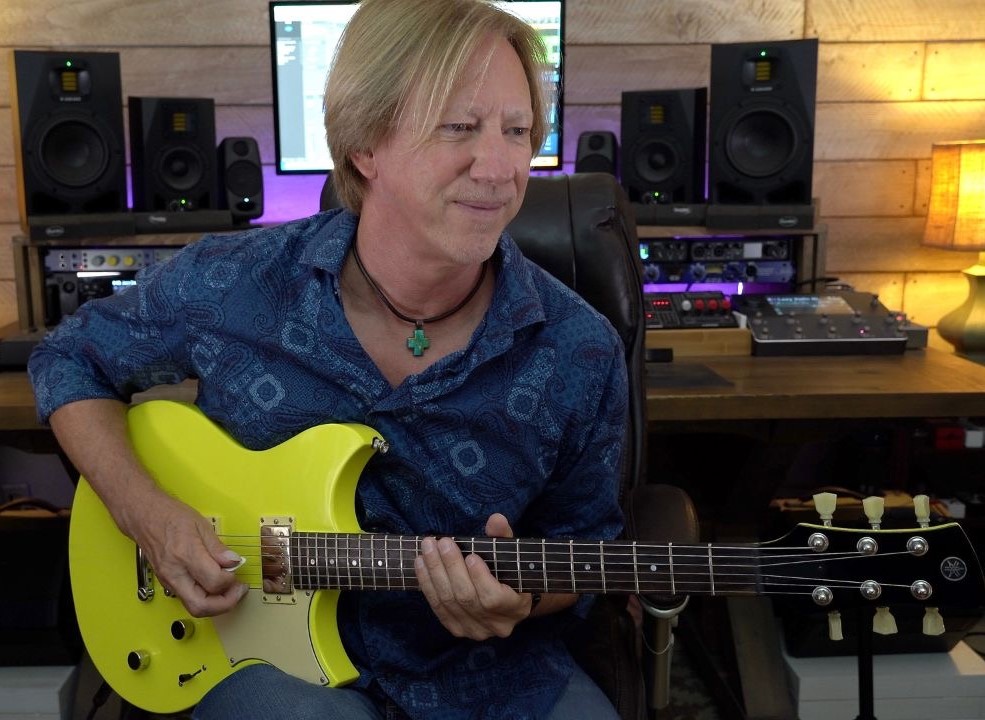Flip the Switch
The transition between the left-brain analytical and the right-brain creative mind.
I took the above photographs at my studio and Hawaiian coffee farm, showing my friend and model, Colleen Boland, with a TransAcoustic LL-TA (left) and CSF-TA (right).
One of the best years of my life was spent in Hollywood, California, attending the Guitar Institute of Technology (G.I.T.) — a program offered by The Musicians Institute, a world-renowned vocational music school with a curriculum specifically designed for contemporary musicians.
G.I.T. employed advanced learning techniques such as visualization. We were also instructed to isolate problem areas and study small chunks of information in order to maximize practice time and accelerate the assimilation of course materials. These techniques were specifically designed to strengthen both the left and right sides of the brain — each of which plays a different role in our thinking and responses.
The left side of our brain deals with the analytical aspects of life. For musicians, this includes music theory, reading music, forming chord and scale shapes, and all the technical aspects of music.
The right side of our brain handles the creative aspects. For musicians, this involves the use of chords and scales for activities such as songwriting, improvisation and live performance.
In this posting, I’ll explore how we can tap into both sides of the brain for exponential technical growth and creative performance potential.
Making the Transition
If you’re a musician, you can think of the two sides as operating this way:
Left brain: Practice time, music theory, motor skills and muscle memory. This is where the heavy lifting is done.
Right brain: Creative pursuits, improvisation and performance. This is where we tap into the left brain’s hard work on a subconscious level, allowing us to trust our abilities.
Wouldn’t it be great if we could flip the switch between the two at will, in order to get the best results from both realms?
Turns out that we can. Here are some ideas to help you make that transition any time you want.
Separate the Functions, Set Your Intention
Begin by separating the analytical and creative functions by identifying which is which during your practice routines. Here’s an example of a practice routine that sets the intention for each function:
Left-Brain Analytical
- Set your intention for practice time (for example, 30 minutes).
- Devote 15 minutes of focused attention to learning a new chord progression. Visualize the shapes of the chords. Name the notes, the intervals and harmonized scale position within each.
- Stand up, take a break, and clear your mind.
- Devote 15 minutes of focused attention to learning a new scale shape. Visualize the shape. Name the tones, study the intervals and contours of the shape.
- Stand up, take a break, and clear your mind.
Important detail: Remove any study material from view. (Referring to charts and diagrams will keep you in the left-brain analytical.)
Right-Brain Creative
- Devote 15 minutes to creating chord progressions with the new chords. Change the tempo, feel and style. Move the notes around in the chords. Have fun with it!
- Stand up, take a break, and clear your mind.
- Devote 15 minutes to improvisation using your new scale shape. Allow yourself to make mistakes and flow through them if and when they occur.
- Stand up, stretch, and conclude your practice routine.
Trust that this focused practice time is enough to achieve lasting results. Remember, unfocused practice time can actually be detrimental to your progress!
Other Ways to Remove the Analytical Mind and Promote Creative Freedom
Close Your Eyes
Removing one of your senses will heighten your other senses, so close your eyes when improvising and trust your ears and the vibrations under your fingers. Jamming in the dark is also an excellent way to flip over to the creative side of your mind.
Trust
Understand that all the study and analytical work you’ve done thus far was achieved with the left-brain conscious mind. But all that wonderful knowledge exists on the creative side too, so all the abilities you’ve worked hard for are available to you when you improvise. Trust, and the notes will appear!
Visualize
Without your instrument, visualize yourself playing perfectly, hitting all the right notes and phrasing them flawlessly. Don’t analyze what you’re doing; just see your best self in your minds-eye. Positive reinforcement of self-image is extremely powerful and will help you unleash your inner rock star.
Listen to the Small Voice
The inner dialogue that we all have running through our minds on a daily basis can destroy a performance. That “small voice” has no place on stage with you. If you hear that nagging critical voice chattering away, shut it down immediately and let your mind be neutral. We don’t need a coach on the sidelines when we are in a creative flow!
Knowledge is Freedom
The more you learn and understand about music, the more freedom you’ll have. In particular, having the skills to analyze progressions quickly will allow you more time to create melodies while performing or recording. For example, let’s assume the two-bar chord progression below is the underpinning for a solo:
I: E7 I A Dma7 :I (x4)
I know from looking at this progression (without even hearing it) that it’s in the key of A, with a tonal center of the E7 chord. This means I can use the A major scale resolving to tones of E7 (E Mixolydian Mode) to create my solo lines. I can also use E7 arpeggios, double-stops and a variety of other scale choices.
Creative Amnesia
When I cross over to right-brain performance mode, I rarely remember the performance — it’s like I’m not really there. I’ve literally watched my video performances and seen myself transition from right-brain to left-brain in order to talk to the camera again. Sometimes I’m in right-brain for the lesson dialogue as well as the performances. It’s as if I’m streaming the information and just acting as the conduit.
Search for Inspirational Sounds
I’m sure we’ve all had those gigs or experiences where our sound was so good that our playing was effortless and inspired. I can’t stress enough the importance of great tone and finding your own voice through your guitar and the equipment you use. If any part of your signal chain is a distraction or delivers sub-standard results, remove or replace it. Having your mind focus on anything other than performance will lock you into the analytical mindset … and that’s not a good thing.
The TransAcoustic range of Yamaha acoustic guitars feature two kinds of onboard reverb as well as chorus … even when they’re not plugged in! (Click here to find out how this magic happens.) I’ve watched guitarists get lost in those tones — so immersed in the sound that their playing gets ratcheted up a notch. As I observe those moments, it’s pretty clear to me that they are almost exclusively under the influence of right-brain creative elements. Those built-in effects are so inspiring, you just want to keep playing!
The Video
For this video, I wanted to create a demo that features two very different Yamaha TransAcoustic guitars: the LL-TA and the CSF-TA. They were both miked (no DI signal was used, even though both guitars have built-in piezo pickups) and double-tracked to capture a natural, full-sounding representation of their acoustic properties as well as the ambient effects emanating from their sound holes.
I used the LL-TA to play the warm rhythm tones you hear in the video, employing a good-quality tube microphone to capture a small amount of the guitar’s onboard room reverb and chorus effects. The CSF-TA was used for the lead lines; I recorded it with the same tube mic to capture a small amount of the guitar’s hall reverb and then added a touch of delay in my DAW during mixing.
The Guitars
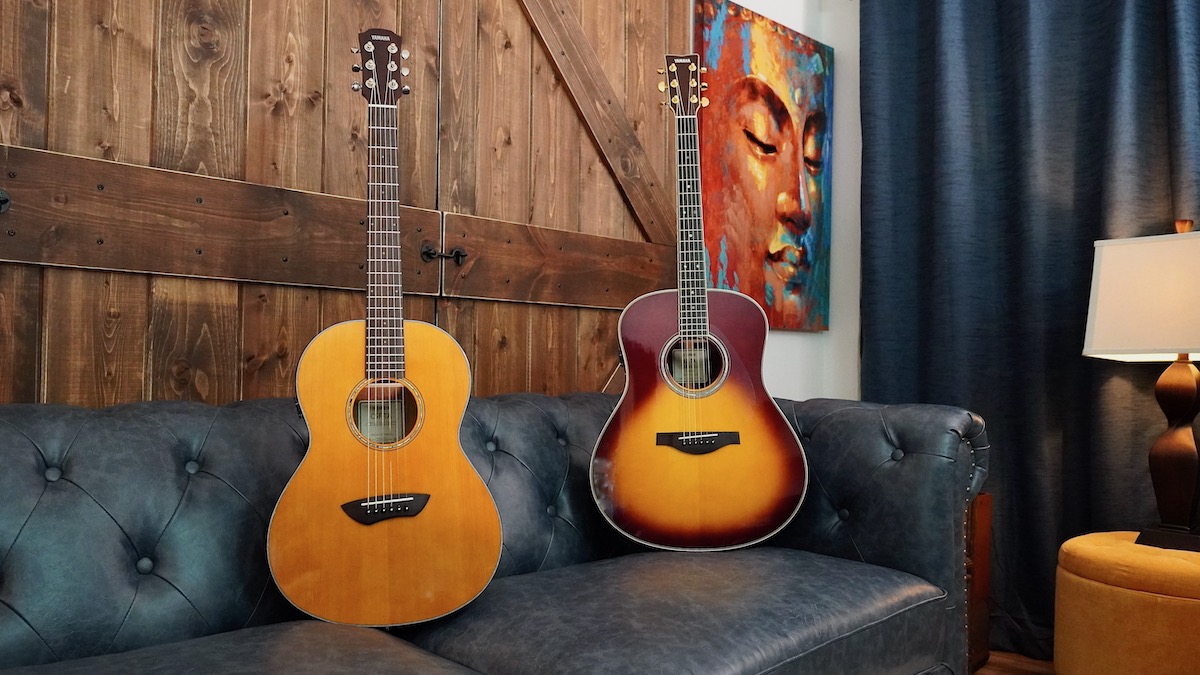
The CSF-TA (on the left) is a small parlor-size guitar that features a mahogany back and sides, a solid spruce top, a rosewood fingerboard and bridge, and those wonderful onboard effects.
The LL-TA (on the right) has a large Western body style and features a solid rosewood back and sides, an acoustic resonance-treated (A.R.E.) Engelmann spruce top, ebony fingerboard and bridge … and, again, those great onboard effects.
The Wrap-Up
You have control over the full realm of creative expression. Work hard and practice with intention … and know that the efforts you make are stored in both your conscious and subconscious mind for use at a later date. How you use that information is up to you.
When it’s time to practice, set your intention for focused study. When it’s time to perform, jam or improvise, set your intention for the perfect performance. Eliminate the small voice of doubt and don’t analyze your playing. Just dial in your tones and trust your creative mind to unleash the powers within.
Photographs courtesy of the author.
Check out Robbie’s other postings.
Click here for more information about Yamaha TransAcoustic guitars.










